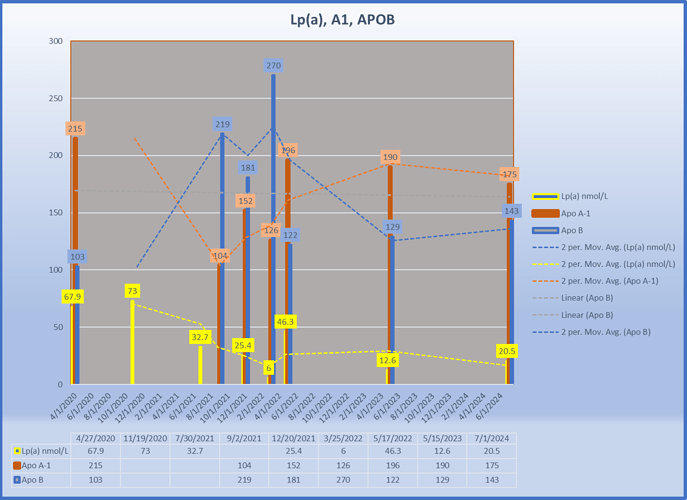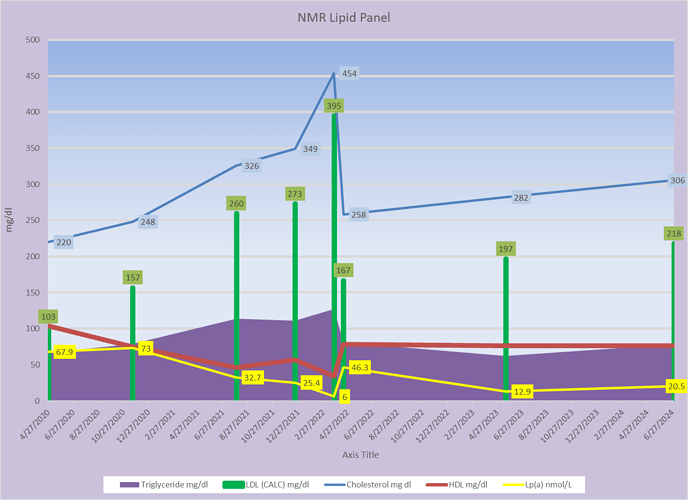I would like to conduct a study on 20 people or so to see if they, like other people who have followed a protocol all have reductions in their Lp(a)…but first I would like to share my latest data, showing a fairly decent stabilization of Lp(a), ApoB and Apo A-1. I first learned about manipulating Lp(a) and thus becoming an admin here through Linus Pauling and Tim Rath’s work. Later upon reading Malcom Kendricks “The Clot Thickens” Along with being Keto/Carnivore for over 8 years, I began to not only take Vitamin C but added more amounts of Lysine and Proline which are amino acids and precursors to collagen. If David Diamond and Malcom Kendricks are correct and heart blockages are formulated by Lp(a) which are first made in the liver using LDL and a protein then I theorize that my results of lowering Lp(a) using Vit C, proline and lysine give my body enough raw material to make the collagen for the arterial wall repair instead of using Lp(a).
I lowered my protocol and saw an appropriate uptick in Lp(a) and ApoB. As I have FV AND FVIII and if Dr. David Diamond is correct, then I have an especial susceptibility to plaques. Although I have dropped my Agatston Score by 8.2% pre-Eliquis, I now take Eliquis due to a COVID related PE of 11 clots in 4 of my 5 lobes.
If we have positive results I have a famous cardiologist in the Ketosphere who has agreed to coauthor the paper.
I would like to conduct a small volunteer study on blood lipids Lp(a), ApoB and Apo A1 to see how controllable it is using Vitamin C, and amino acids proline, and lysine. It doesn’t matter what your current Lp(a) level is, we want to understand if the protocol changes all levels of Lp(a) not just the high amounts.
I have already posted on this In Lp(a) the Keto Solution, but- Let’s delve into the science behind it.
Lp(a) and Fibrinogen: A Complex Relationship:
- Lp(a) consists of an LDL cholesterol particle bound to a unique glycoprotein called apo(a).
- Apo(a) shares structural similarities with plasminogen, a protein involved in clot dissolution.
- Lp(a) is known for its role in atherosclerosis and cardiovascular disease.
- Fibrinogen, produced by the liver, is converted into fibrin when blood vessels are injured.
- Fibrin stabilizes blood clots at the site of injury.
- Lp(a) competes with plasminogen for binding sites on fibrin, inhibiting clot breakdown.
- Elevated Lp(a) levels may contribute to increased atherosclerosis risk.
Vitamin C and Collagen Repair:
- Vitamin C plays a crucial role in collagen synthesis, which forms the structural backbone of blood vessels.
- When blood vessels are damaged, Vitamin C helps repair collagen, strengthening arterial walls.
- By promoting collagen repair, Vitamin C reduces the need for Lp(a)-based “band-aid” plaques.
Proline and Lysine Competition:
- When blood vessels are damaged, binding sites within collagen become exposed.
- These binding sites primarily contain two amino acids: proline and lysine.
- Nobel Laureate Linus Pauling proposed that supplementing with proline and lysine can compete with circulating Lp(a).
- Essentially, proline and lysine bind to Lp(a), preventing it from attaching to exposed sites in damaged blood vessels.
- Meanwhile, Vitamin C continues its healing work.
Hypothesis : Simply, when Vitamin C is in the blood stream at ample amounts, Lp(a)goes down, Lp(a) goes up without adequate Vitamin C
Study Details:
- Duration: 12 weeks
- Participants: Approximately 10 women and 10 men
- Protocol:
- 12 g of Vitamin C (ascorbic acid ONLY) daily, spread throughout the day
- 3 g of lysine and 1 g of proline daily (either together or spaced out)
- Testing: Lp(a), ApoA1, and ApoB measured three times during the study.
Cost : Siobahn at www.ownyourlabs.com will offer bundle pricing for participants as well as an increased discount on other tests you may want to run. You are expected to pay out of pocket for the testing and the supplements. The tests costs are as follows:
Lp(a) $35.20, ApoB $17.20, ApoA1, $18.21
Total 1 time $70.61
3 Times $211.83
with discounts testing price would be $169.46
$169.46 plus the cost of your supplements with no requirement on brand of supplement.
Lp(a) and Fibrinogen: A Complex Relationship
Lp(a) Overview:
Lipoprotein(a) (Lp(a)) consists of an LDL cholesterol particle (the “Lp” part) bound to a unique glycoprotein called apo(a).
Apo(a) shares structural similarities with plasminogen, a protein involved in clot dissolution.
Lp(a) is known for its role in atherosclerosis and cardiovascular disease.
Fibrinogen and Clot Formation:
Fibrinogen is a soluble protein produced by the liver.
When blood vessels are injured, fibrinogen is converted into fibrin by the enzyme thrombin.
Fibrin forms a mesh-like network that stabilizes blood clots (thrombi) at the site of injury.
Lp(a) and Fibrinogen Interaction:
Lp(a) has a fascinating relationship with fibrinogen:
Lp(a) competes with plasminogen for binding sites on fibrin.
When Lp(a) binds to fibrin, it inhibits the action of plasmin, preventing clot breakdown.
Essentially, Lp(a) acts as an “anti-fibrinolytic” agent, promoting clot stability.
This interaction may contribute to the increased risk of atherosclerosis associated with elevated Lp(a) levels.
Clinical Implications:
- High Lp(a) levels are an independent risk factor for cardiovascular disease.
- Individuals with genetically elevated Lp(a) may have a higher propensity for clot formation.
- Strategies to reduce Lp(a) levels (such as your proposed protocol) could impact clot stability.
- Your initiative to improve our understanding of Lp(a) and ApoB control is commendable! If anyone wants to participate, they can visit your link at www.ownyourlabs.com. The bundle pricing and discounts for participants make it accessible.


If you would like to participate please contact me by PM, in the comments section. I will be posting next week a Entry Form.
Feel free to reach out if you need further information or assistance!


